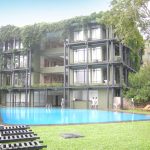-
When Typography Meets Furniture
October 2012

Typography is an art and technique of arranging type in order to make language visible. For centuries man has been closely associated with typography as a form of communication.
By Shenuka Dias
Varying amongst most nations, typography has now evolved into a complex tool that has become visible in any surrounding in diverse forms. It is a new avenue in typography which looks beyond the means of a medium of communication. The following examples of contemporary furniture, fuses typography as a form of inspiration proving that possibilities are endless.
Typographic forms can be moulded, bent, or joined to form whole or elements of furniture pieces.
The design of typographic furniture can be categorised based on the orientation of its inspiration such as; the reflection of typography in its form and the other on its surface. Typographic forms can be moulded, bent, or joined to form whole or elements of furniture pieces. Similarly, typography can also be printed, laser cut, engraved, sticker cut, stencilled, cut out, or textured onto the surface of the furniture piece.
TABISSO is a French design company focusing on high-end, typographic lounge furniture. Their chair line includes letters A-Z and numbers 1-9, and the coordinating floor lamps cover more than 20 punctuation marks. All of their products are made-to-order in France, and chairs can be custom upholstered with fabrics or leathers in a spectrum of colours. The wooden shell and metal footing also have a variety finishing options.
The A Stool by Design studio By ALEX, is a part of a collection inspired by playful typography consisting of The A Stool, The A Side Table and The A Coat Stand. The A Range is a stylish yet functional collection of furniture which is formed from interlocking ‘A’ shapes of plywood. Such a design provides strength and longevity, whilst reflecting a love of typography. It comes flat pack and with an easy guide to assemble and disassemble. Finished using a natural lacquer, the A Range is a blank canvas and comes in two colours, white and smoke grey.
Designed by graphic designer Roeland Otten, each chair represents a letter of the alphabet. The chair is an alphabet to sit on and a series of chairs to form words with. It consists of a series of 26 typographic chairs that can be arranged to form words.
FONTABLE is a series of alphanumeric elements reproducing letters A-Z in lower and uppercase and numbers 0-9. The graphic, three dimensional ‘type’ becomes the protagonist of a new language in design which is both versatile and eclectic, giving the possibility to shape the environment in ever evolving and surprising ways. These tables are produced in steel sheet with lacquered varnishing and anodised aluminium legs at adjustable height, allowing overlap of table surfaces to compose words to express and communicate.
Folded down or flipped up, there is no mistaking what this matte black, punched-metal product was made for, in black or white, facing forward, or even from a worms-eye view via the floor below. Typeshelf brings typography into product design by using the word as the object. 2D cut out letters on stainless steel are bent along the perforations at the bottom to form the “shelf”. The material characteristics of steel provide a sturdy platform for books etc. without requiring additional hardware.
The Dharma Lounge, designed by Palette Industry is an interesting approach for a chair. This has come to fruition through the exploration of using text as both structure and decoration. The purpose of this chair is to create a situation where the participant is embraced by the possibilities of creating a relationship with the object based on personal and communal experiences and memories thus substantiating the lifespan of the product. The use of laser cutters in furniture design has made these typographic efforts relatively easy to produce. The Lounge chair is cut to display the following saying: stand, forget, breathe, acknowledge and observe. Customisable colours, text and languages are an optional in this design.
Another calligraphic chair designed by Palette Industry is the sleek powder-coated aluminium piece of functional art which is sprayed in black and white. Using typography as form and structure, Palette and the editorial team of Gilt Home found it befitting to use the quote “There’s No Place Like Home.”
This typographic coffee table is an attempt by Peter Haggard to mix typography with furniture in several ways. Using the typeface Palatino, the form of the table was created as an attempt to explore what a table might look like if it was a letter in the alphabet. Expressive typography was CNC cut into the table to create a description of what someone might find on any coffee table.
The aluminium calligraphic coffee tables in five vibrant colours are the creative work of Jordanian furniture designer Dina Gildeh. Dina has composed the type to form the surface of the two table designs while carefully removing the excess pieces.
Why not try using typographic furniture in an interior such as a internet cafe, book store or library? There’s no doubt that typography as wall art is definitely becoming more and more popular, however, design possibilities using Sinhalese type on furniture are yet to be explored.























